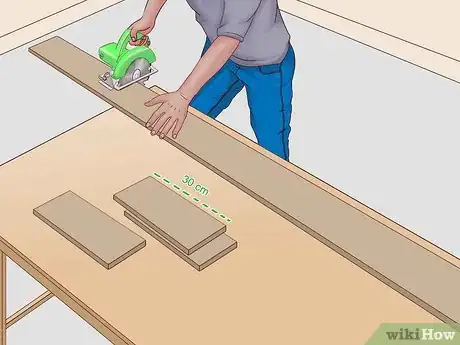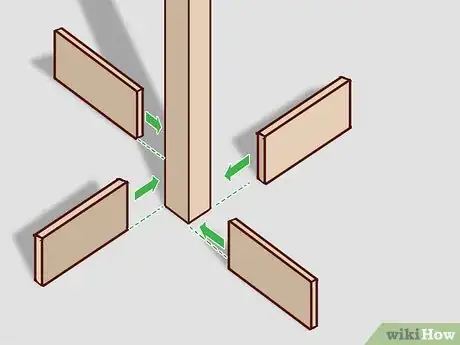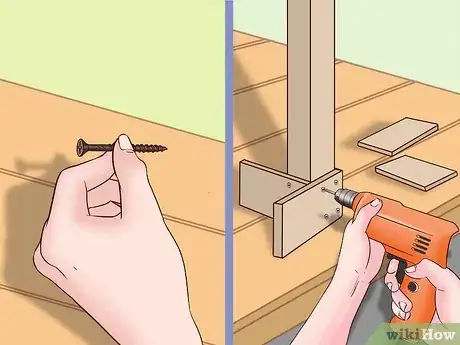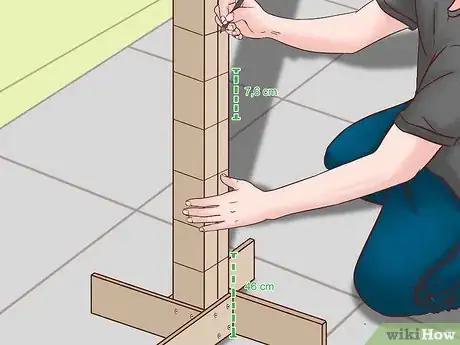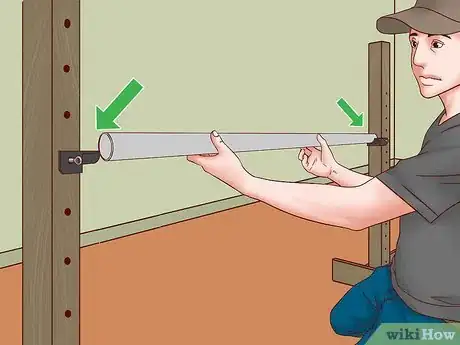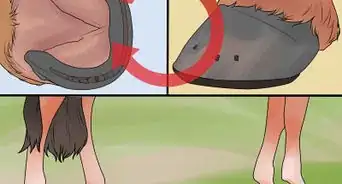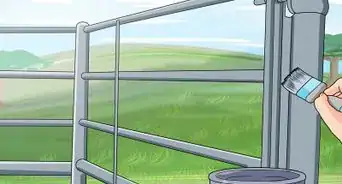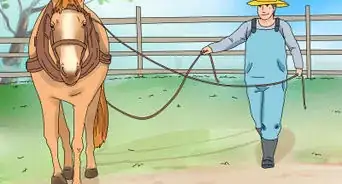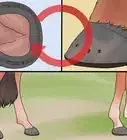This article was co-authored by wikiHow Staff. Our trained team of editors and researchers validate articles for accuracy and comprehensiveness. wikiHow's Content Management Team carefully monitors the work from our editorial staff to ensure that each article is backed by trusted research and meets our high quality standards.
This article has been viewed 172,421 times.
Learn more...
A schooling jump standard is a common type of equestrian jump that comprises 2 vertical beams, a crossbar, and feet to support the vertical beams. If you own or work with horses and would like them to be able to jump as part of their regular arena training, building your own pair of schooling standard jumps is a practical idea. All of the supplies you'll need should be available at a local hardware store. This is a relatively cheap and easy process; it shouldn't cost more than $30 USD and will only take up an afternoon.
Steps
Assembling the Posts
-
1Cut an 8 ft (2.4 m) long board in 8 sections of 1 foot (0.30 m). Use a circular saw to cut a single 8 ft (2.4 m) long 2 in × 8 in (5.1 cm × 20.3 cm) board into 8 equal lengths of 12 in (30 cm) each. Be sure to measure the length with a tape measure before cutting, so you don't cut the boards to the wrong length.[1]
- These 8 segments will form the feet of the jump, so they should all be identical in length.
-
2Position 4 feet around each of your 2 vertical posts. The 2 posts that form the vertical side pieces of the standard jump will each be made from a 4 in × 4 in (10 cm × 10 cm) 6 ft (1.8 m) pressure-treated post. To keep the 2 posts steady, each will have 4 feet around its base. Stand each of the posts upright, and place 1 foot against each side of its base.[2]
- Situate the butt of 1 foot flush with 1 edge of the post. Place the second foot so it butts up against the first, the third so it butt up against the second, and the fourth so it butts up against the third.
- Think of the feet positioning like hands on a clock. Each of the 2 high posts will have a foot located at 12, 3, 6, and 9 o'clock. Visually, they'll more or less resemble a pinwheel pattern.
Advertisement -
3Screw the feet onto the bottom of the posts with 4 deck screws per foot. Once the feet are in place, you're ready to attach them to the vertical poles. On all 4 feet, set each of the 4 screws in at least 1⁄2 in (1.3 cm) from the outer edge of the post. A power drill is the most efficient tool for the job. Place a Philips head bit on the drill, and screw each of the deck screws firmly into place.[3]
- You'll need 32 deck screws total. Deck screws are a little more expensive than other kinds of screws, but won't deteriorate in pressure-treated lumber.
Marking and Drilling the Vertical Poles
-
1Mark 9 lines at 3 in (7.6 cm) intervals up one of the posts. Make sure that the 2 posts are standing on a level, flat surface. Then, use a tape measure to measure up the post 18 in (46 cm) from the ground. Use your pencil to make a mark on one of the flat sides of the post. Using the level, draw a horizontal line through the mark. Draw another line at the same height on the opposite side of the post. Then, continue measuring up the post in 3 in (7.6 cm) intervals until you've marked 9 lines.[4]
- Repeat the process on the second vertical post by measuring and marking lines first at 18 in (46 cm) and then at intervals of 3 in (7.6 cm) until you have drawn 9 lines.
- These marks must be completely level and centered or your jump cups won't fit correctly into the posts.
- When you've finished, the 2 posts should each have 9 lines marked around them at the same heights.
-
2Mark the center of each of the 9 lines on the posts with an "X." Measure the width of one of the vertical edges of the post and divide by 2 to find the center. The result should be close to 1.5 in (3.8 cm). Use a pencil to mark an “X” at the center of the lowest line on the post. Then measure the halfway point at the line of the same height on the other side of the post. Make another “X” here.[5]
- Make sure to be consistent and mark your “X” markings on the same 2 sides of the post. Do this for each of the 9 lines you've drawn on both posts.
- Repeat this process on the second post as well. Keep in mind that, when marking the center of the 9 lines on the second post, you won't need to re-measure the width of the post, since the 2 posts are the same size.
-
3Drill holes straight through the 9 sets of “X” marks on both posts. Set a 1⁄2 inch (13 mm) drill bit in your power drill. Then, position your drill bit against the first of your “X” markings on 1 of the posts. Hold the drill level, and drill straight through the post.[6] Drill slowly for the sake of accuracy, and aim the drill bit for the “X” on the back side of the post. Drill 9 holes: 1 through each set of “X” marks you drew.
- Then, repeat the process and drill 9 more holes through the second post. As with the first post, hold the point of the drill bit in the center of an “X” mark, keep the bit level, and drill straight through the post.
- Make sure that the holes you drill through the posts are all on the same 2 sides. None of the drilled holes should be perpendicular to each other.
Finishing the Jump Standards
-
1Place the plastic jump cups into the holes you drilled on each pole. To complete the jump, you'll need 2 jump cups: 1 for each of the 2 poles. Each jump cup will have 2 1⁄2 in (1.3 cm) plastic nubs that you can insert into the holes you drilled to hold the cup in place. To clip the jump cups into place around the poles, firmly grasp 1 of the plastic arms in each hand. Spread the jump cup apart, slide the nubs into the drilled holes, and then release the jump cup so that the nubs slide securely into the holes.[7]
- The jump cups will hold the bar at the height you select loosely enough that, should your horses' hooves collide with the bar, it'll easily fall from the cups.
-
2Set a 6 ft (1.8 m) PVC pipe in the jump cups. Only do this when you're planning to jump your horse. Begin by setting the 2 posts 6 feet (1.8 m) apart. Set the jump cups to the height you want, and set the PVC pipe in position so that 1 end of the PVC pipe is in each of the 2 jump cups. Make sure that both jump cups are at the same height, or the PVC will be uneven.
- A PVC pipe is light enough that, should your horse miss the jump and hit its hooves or knees against the bar, it won't injure itself.
- If you're concerned that PVC is too light, use landscaping timbers as a heavier alternative.[8]
-
3Apply 2-3 coats of white exterior house paint to the wooden surfaces. To give the jump a more polished look, dip a 3 in (7.6 cm) paint brush into a can of white paint. Work in long, vertical strokes to apply the paint to all of the wooden surfaces of your standard jump. These include the 2 vertical posts and the 8 feet.[9] Not only will the white paint make the jump look nice, it will also make it easier for your horse to see as it prepares to leap over it.
- If you prefer not to paint the jump, try applying a coat of stain instead. This will still protect the wood from the elements but won't flake off with time.
Community Q&A
-
QuestionWhere can I purchase jumping cups?
 Community AnswerYou can purchase jumping cups at Dover Saddlery or any horseback riding supply store.
Community AnswerYou can purchase jumping cups at Dover Saddlery or any horseback riding supply store. -
QuestionWhat size pipe will fit in the jump cups ?
 Community AnswerLandscaping timbers work best. PVC shatters easily so don't use it.
Community AnswerLandscaping timbers work best. PVC shatters easily so don't use it. -
QuestionHow long is the pole?
 Community AnswerThe average length of the jumping poles range from 70cm to 3m. But shorter ones should NOT be used for jumping, only walking over. The average jumping pole seems to be 2m.
Community AnswerThe average length of the jumping poles range from 70cm to 3m. But shorter ones should NOT be used for jumping, only walking over. The average jumping pole seems to be 2m.
Warnings
- Do not use PVC pipes as poles. Although they're sturdy and easy to work with, they can be dangerous to your horse. When PVC, breaks it creates sharp spears that could stab your horse!⧼thumbs_response⧽
Things You'll Need
- Circular saw
- Tape measure
- Power drill
- 1⁄2 inch (13 mm) drill bit
- Level
- Pencil
- Two 4 in × 4 in (10 cm × 10 cm) 6 in (15 cm) pressure-treated posts
- One 2 in × 8 in (5.1 cm × 20.3 cm) 8 ft (2.4 m) pressure-treated board
- One 6 ft (1.8 m) PVC pipe
- Small box of 3 in (7.6 cm) deck screws
- 1 pair jump cups
- 3 in (7.6 cm) paint brush
- White exterior house paint
- Landscaping timbers
- Stain (optional)
References
- ↑ https://listentoyourhorse.com/creative-ways-to-make-your-own-horse-jumps/
- ↑ https://www.horseillustrated.com/horse-exclusives-building-jump-standards
- ↑ https://listentoyourhorse.com/creative-ways-to-make-your-own-horse-jumps/
- ↑ https://www.horseillustrated.com/horse-exclusives-building-jump-standards
- ↑ https://youtu.be/Bw9PNXjIqZ4?t=731
- ↑ https://www.horseillustrated.com/horse-exclusives-building-jump-standards
- ↑ https://listentoyourhorse.com/creative-ways-to-make-your-own-horse-jumps/
- ↑ https://youtu.be/Bw9PNXjIqZ4?t=40
- ↑ https://listentoyourhorse.com/creative-ways-to-make-your-own-horse-jumps/
